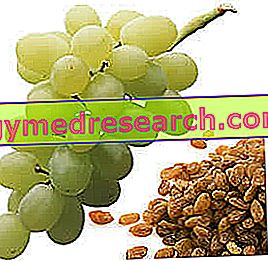Sultana and Grape Raisins: Differences
Very often, the terms Uva Sultanina and Uva Passa (or Uvetta) are improperly used as synonyms; however, while sultana is a variety of the Vitis vinifera species ( Vitacee Family), raisins are a TYPE of preserved food (obtained by dehydration in the sun or in a stove) belonging to the group of dehydrated fruit.

Another type of apirena grape that lends itself to drying to obtain raisins is the black Corinth, characterized by seedless and parthen-parcus berries (completely devoid of seeds), generally small and dark purple. Moreover, due to the strong similarity in the dehydrated form, it is not uncommon for the sultanas to be confused with that of the Zibibbo; they are both white, but the zibibbo is not produced by apyrene, therefore it maintains its seeds (fundamental for winemaking).
To indicate more precisely the dehydrated shape of white sultanas, it would therefore be necessary to call it "Uvetta Sultanina" or "Uva Sultanina Passa".
Sultana grape
The sultanas is a cultivar with rather ancient origins. It is conceivable that it derives from a region of south-western Asia, from where it would then spread to the eastern Mediterranean. The sultanas is a vigorous vine, with little fertility of the basal buds, which requires a long pruning and lends itself to expanded forms (ad Y or awning); requires fresh, deep soils and warm climates.
Other names of sultanas are: Kish Mish (IR), Couforogò (GR), Sultana (ZA, P, AUS), Thompson seedless (USA) and Uva de Pasa (ROU).
The sultanas are suitable for "fresh" consumption, but also for the production of juices, distillates and (obviously) raisins. The grape is small, ellipsoidal, yellow or golden in color and contains a crunchy pulp. In natural form, it already has a very sweet and not very complex taste, while the peel is thin, with little bloom and easy to chew.
Nutritional Features
The sultanas is a preserved food and, more precisely, dehydrated. It does not contain much water and this is to the detriment of one of the MAIN fruit functions, namely the increase of dietary water intake with food.
The sultanas raisins are therefore a real nutritional and caloric concentrate, the latter due to the high amount of fructose it contains; this characteristic, if on the one hand it makes it an extremely energizing food, on the other it excludes it from dietary regimes useful for weight loss or glycemic / insulin control.
| Composition for 100g of Dried Grapes - Reference values of the INRAN Food Composition Tables | ||||||||||||||||||||||||||||||||||||||||||||||||||||||||||||||||||||||||||||||||||||||||||||||||||||||||||||||||||||||||||||||||||||||||||||
 | ||||||||||||||||||||||||||||||||||||||||||||||||||||||||||||||||||||||||||||||||||||||||||||||||||||||||||||||||||||||||||||||||||||||||||||
Nutritional values (per 100 g of edible portion) | ||||||||||||||||||||||||||||||||||||||||||||||||||||||||||||||||||||||||||||||||||||||||||||||||||||||||||||||||||||||||||||||||||||||||||||
| ||||||||||||||||||||||||||||||||||||||||||||||||||||||||||||||||||||||||||||||||||||||||||||||||||||||||||||||||||||||||||||||||||||||||||||
The considerable nutritional concentration also affects the other molecules of sultanas raisins, for example: dietary fiber, mineral salts and various phenolic substances.
In particular, the fiber abundantly contained in sultanas could be very useful in the fight against constipation even if, to carry out its function, it requires to be rehydrated with water.
As far as mineral salts are concerned, sultanas raisins boast a very high concentration of potassium (useful in regulating blood pressure); moreover, even the quantities of calcium and iron do not disappoint but, due to their poor bioavailability, they are not completely absorbable.
A final note of merit must be made for the concentration in phenolic substances; these, although not shown in the table below, represent one of the most important components of sultanas. They have a strong anti-oxidant, anticancer, cholesterol-lowering and positive action on carbohydrate metabolism. However, it is essential to remember that it is an extremely caloric food and that, "antioxidants aside" ... provides high concentrations of sugars. Excessive portions of raisins could therefore nullify the marked power of regulation of glucose metabolism.
We conclude by specifying that, in addition to what has been said so far, the phenolic substances of this food seem to contribute to the moderation of the bacterial charge present in the oral cavity, thereby hindering the formation of caries. On the other hand, we recall once again that it is a product with a very high glucose content, which is itself a risk factor for dental degeneration.
Another "potentially antioxidant" factor contained in sultanas is represented by the complex of melanoidins, or molecules responsible for food browning after dehydration.
NB . A chemical and compositional analysis showed that raisins, compared to fresh ones, also have a lower content of pesticides; this reduction is attributable both to washing and to the action of heat than to that of distilling.
Bread With Raisins (Without Eggs)
X Problems with video playback? Reload from YouTube Go to Video Page Go to Video Recipes Section Watch the video on youtube



